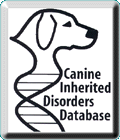
Acral mutilation syndrome
This is a bizarre syndrome in which dogs lose pain sensation in their toes. This is due to abnormal development and slowly progressive degeneration after birth of the sensory neurons in the spinal cord and in peripheral nerves.
Affected dogs initially chew at their feet but eventually will do extensive damage.
This condition is believed to be autosomal recessive.
Affected pups usually begin to bite and lick their feet at 3 to 5 months of age, and have no temperature or pain sensation in the toes and sometimes up the legs. The hind legs are most severely affected.
Your dog's toes and feet will become swollen and ulcerated. S/he will continue to walk without any apparent discomfort on the mutilated feet.
Unfortunately attempts to prevent further mutilation are generally unsuccessful.
The diagnosis can usually be made based on distinctive clinical signs in a young dog of a typical breed. More than one pup in a litter may be affected. Electromyography will give a definitive diagnosis by revealing an absence of normal nerve potentials in your dog.
Diagnosis can also be made at necropsy, based on the characteristic changes in the nervous system.
Unfortunately there is no treatment. Attempts to prevent mutilation through the use of bandages, collars or sedation are unsuccessful and, as the mutilation worsens, owners generally request euthanasia.
There is no test for carriers of this disorder. Parents and siblings of affected dogs should not be used for breeding.
FOR MORE INFORMATION ABOUT THIS DISORDER, PLEASE SEE YOUR VETERINARIAN.
Scott, D.W., Miller, W.H., Griffin, C.E. 1995. Muller and Kirk's Small Animal Dermatology. p 799. W.B. Saunders Co., Toronto.
- Disorder Type:

